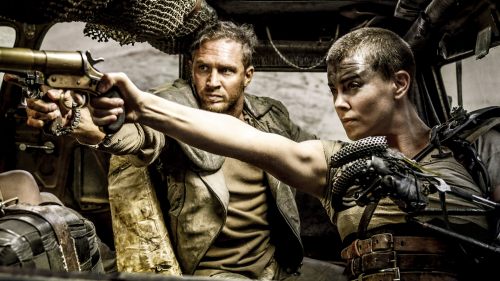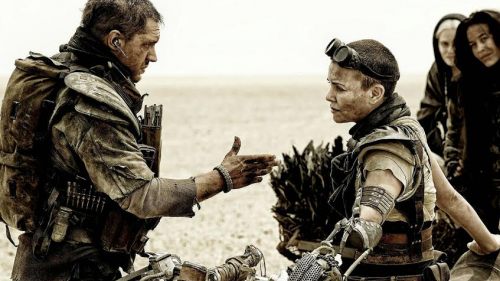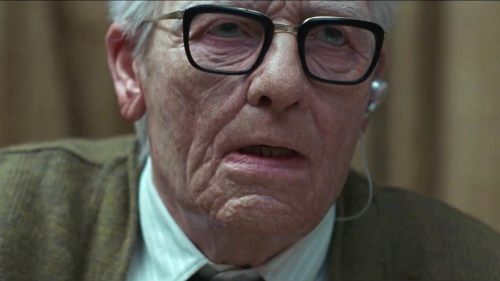From Frogtown to Gastown: Feminism in the Apocalypse
These days I’ve been doing a lot of thinking about what it means to be a woman in a man’s world. It’s hard to watch the news and not find myself envisioning a dystopian future where any sign of femininity is a liability, and every night when I find my place in the irradiated dirt, I thank my lucky stars for getting Lasik and an IUD before the world turned to shit.
That feels pretty real to me. But maybe it’s just the movies I’ve been watching:
The sun blazes down relentlessly on a desert wasteland, all that remains of a familiar English-speaking country in the aftermath of devastating nuclear war. A dust-caked vehicle makes its way into frame, screaming down the endless stretch of packed earth that passes for a road in this hellscape.
Inside the retrofitted truck, we find a masculine hero, a sharp-shooting bad bitch, and a backseat stuffed full of dizzying beauties—all of them pursued by a grotesque warlord hell-bent on reclaiming his harem.
I’m not watching Mad Max: Fury Road for the dozenth time. No, this is Hell Comes to Frogtown, a movie released a full 27 years earlier. Let’s zoom out for a minute.
In the wake of Mad Max (1979), The Road Warrior (1981), and Mad Max Beyond Thunderdome (1985), George Miller’s engrossingly singular Mad Max universe spawned a whole host of grimy, low-budget doppelgängers. Arguably chief among them is Donald G. Jackson’s feverish homage, Hell Comes to Frogtown.
Frogtown is unrepentant schlock that earned its cult status by handily out-crazying its source material at every opportunity. Where Mad Max has motorcycle gangs, Frogtown has a crime ring of mutated frog-men. Where The Road Warrior has a wild-eyed feral kid, Frogtown has sex-crazed feral women. Where Thunderdome leans into Mel Gibson’s leather-clad swagger and questionable haircut, Frogtown ups the ante on hyper-masculinity with “Rowdy” Roddy Piper rocking a full-blown Canadian tuxedo—shirtless—and a somehow even more questionable haircut.
When Hell Comes to Frogtown was released in 1988, three years after Thunderdome, nothing about the film warranted a close reading. It was a wild ride through a nostalgic facsimile of Mad Max’s Wasteland, and it did something to fill the void left when Miller shelved his universe. A fun little movie to send your uninitiated friends into fits of laughter, but nothing more.
27 years after Frogtown, George Miller returned to the Wasteland with Mad Max: Fury Road. At the time, a scant few cinephiles pointed out its similarities to Frogtown, but no one in the blogosphere offered thoughtful analysis. Even recent interviews with George Miller fail to raise the question of why Fury Road shares so much in common with its lo-fi predecessor. For what it’s worth, Miller has stated on the record in at least one interview that the plot for Fury Road came to him in 1999, when he “conceived of a story where violent marauders were fighting, not for oil or material goods, but for human beings.”
I’m here to tell you that, without a doubt, Hell Comes to Frogtown got there first.
Yes, I think that Mad Max: Fury Road is a blatant rework of a Mad Max knockoff movie featuring mutated frog-men. More importantly, I believe this fact does nothing to diminish Miller’s filmmaking. On the contrary, the too-close-for-comfort parallels between these movies only further establish Fury Road as a work of feminist-allied genius, and a master class on gender relations in storytelling.
How similar are these movies? It all starts with our titular heroes: Tom Hardy’s “Mad” Max Rockatansky and Roddy Piper’s Sam Hell. Both men are undeniable physical specimens. Tom Hardy’s notable capacity for muscularity was well known to audiences by the time of Fury Road’s release, as Hardy had packed on nearly 30 pounds to play Bane in 2012’s The Dark Knight Rises. For his part, Roddy Piper’s work with the WWF around the time Frogtown came out pitted him against those indisputable legends of sports entertainment, Hulk Hogan and Mr. T. Suffice it to say that Piper and Hardy were cast in no small part because they look like unambiguously macho, manly dudes.
But they’re action movies! Action movies star ripped guys—that’s a given. Both Frogtown and Fury Road, though, use their muscle-bound stars as tools to put an unexpected spin on the established arc of the action hero. Tom Hardy and Roddy Piper are treated like pieces of meat. Not like pieces of ass, to be clear, but pieces of meat. Both Mad Max and Sam Hell are unwillingly dragged into the action, not because they are brave or strong, but because their bodily fluids are valuable from the perspective of their dystopian future societies.
Max’s story starts when he’s captured by the War Boys, an army of young men rapidly dying of radiation sickness and in constant need of blood transfusions to keep fighting. When Max’s blood type turns out to be the universal donor, he’s branded, tattooed and reduced to a “blood bag,” the unwilling blood supply for a sickly War Boy with a death wish.
Sam Hell’s story starts in an eerily similar way: he’s captured by the Med-Techs, a faction of the all-female governmental regime who use virile men as a tool in their fight to repopulate the earth. When Sam turns out to be a fertile male, an increasingly rare commodity in the post-nuclear future, he’s fitted with an explosive tamper-proof chastity belt, branded “property of the Provisional Government,” and enlisted as a soldier in the repopulation effort—whether or not he’s up for the challenge, emotionally speaking.
Already it seems like Max and Sam could easily commiserate about the unexpected and physically demoralizing circumstances they find themselves in. If Sam Hell could stop himself from cracking wise long enough for notably laconic Mad Max to work up something to say about it, that is. But we don’t yet have a blatant example of the Mad Max canon universe absorbing and repurposing elements of its own fandom. That comes once we meet the women.
The fight that Max and Sam are dragged into, kicking and screaming, isn’t their own. In both movies, the fight, the plan, and the glory belong to a woman who resolves to kick ass and take names on behalf of other women.
Sam meets Spangle, an unflappable Med-Tech on a quest to save a group of young, fertile women from sexual slavery under the grotesquely mutated Commander Toty and his army of irradiated frog-men. Max meets Furiosa, a defiant War-Rig driver on a quest to save a group of young, fertile women from sexual slavery under the grotesquely mutated Immortan Joe and his army of irradiated War Boys.
In all seriousness, the only real difference in terms of major plot here is that Immortan Joe is ostensibly a human being, while Commander Toty is a giant mutated frog with three penises.
Once we get in the car—either Furiosa’s War-Rig or Spangle’s Med-Tech vehicle, it doesn’t matter which—we get a good look at these young, fertile women. There are five harem escapees in Fury Road, and another five in Frogtown (though only four of them make it into the car). Stuffed into the backseat, the sight of these nine beautiful, meticulously groomed women has a surreal effect, not unlike a mirage in the irradiated desert landscape. They interlace fingers and link arms in an ever-shifting tableau of female solidarity, still wearing the impractical, revealing costumes that clearly mark them as sex slaves.
When the harem escapees start to talk, it’s clear that despite their circumstances, they are far from the shell-shocked, glorified props you’d expect them to be. They have identities of their own, which they’ve constructed in direct opposition to the oppressive violence of the societies around them. In Frogtown, the escaped women call themselves Passives. They abhor violence, believing that “only the truly meek will inherit the earth.” In Fury Road, Rosie Huntington-Whiteley’s Angharad speaks for her group, proclaiming there will be “no unnecessary killing” and calling bullets “Anti-Seed. Plant one and watch something die.”
The razor-sharp parallels between these two groups of women can be pinpointed in a single, uncannily similar scene in both movies. During a heated shoot-out in Fury Road, Furiosa exhausts the ammunition in her rifle and tosses it to Angharad in the backseat. “Reload the clip,” Furiosa demands. Angharad stares wide-eyed at the weapon in her lap, “I…I can’t.” It’s clear that this isn’t a simple matter of Angharad not knowing how to load the weapon; she will not follow the order on moral grounds.
In Frogtown, Sam Hell, Spangle and the Passives are ambushed and held at gunpoint. Their only hope of defense is Sam’s sword, sheathed on his back just out of his reach. “Hand me my sword,” he whispers to the woman behind him, one of the unnamed harem escapees. She shakes her head and replies: “I can’t. I’m Passive.”
To my eye, these scenes are virtually the same, and offer the most solid evidence for the influence of Frogtown on the plot of Fury Road. Fundamentally, they both uphold the same moral lesson: these women were worth saving because they refused to take part in the ubiquitous violence around them.
Once you’ve noticed the parallels, it’s really easy to see Mad Max: Fury Road as a brilliant rework of the plot of Hell Comes to Frogtown. But it’s no surprise that these movies aren’t routinely mentioned in the same breath—not because of the nearly 30-year span of time between their releases, but because, while they share a similar strange premise, a similar cast of unlikely characters and similar specific ideological messages, the two films are resolved so differently that it renders them nearly incomparable.
Where Donald G. Jackson’s characters play out a heterosexual white male nightmare of emasculation and duty, George Miller’s tale unfolds into a populist epic with complex implications for modern feminism. If you want to understand why, you have to look at the question asked repeatedly over the course of Fury Road: WHO KILLED THE WORLD?
The answer for both the women of the Wasteland and the escapees from Frogtown is the same. Men killed the world with nuclear war. Men laid waste to the land and poisoned their bones with radiation. Men robbed humanity of healthy babies and a future.
In Frogtown, humanity’s solution to the problem of nuclear fallout was forcible takeover by a female-run government. At first it seems like a fair and fitting punishment for the world’s remaining men, simple retribution for the senseless violence they perpetrated when they held power. It’s a tempting revenge fantasy, imagining the current political status quo overturned and replaced with its polar opposite.
But the society of Frogtown seems no better off. They’ve simply traded nuclear war for the fight to repopulate the earth, and an overbearing male government for an equally overbearing female counterpart. The new regime may look different, but the average man or woman is still a pawn to be played. By the end of Frogtown, Sam Hell’s life doesn’t look much different than it did in the beginning. He remains a captive, required to fulfill his duty of impregnating as many fertile women as possible whether he wants to or not. By the end of Frogtown, when Sam finally realizes that his fate is beyond his control, he offers up a smile and accepts it. He’s still government property, still only as good as his bodily fluids.
The Passives face a similarly disempowering end. They’re freed from sexual slavery, only to be immediately recruited in the fight for repopulation. “Don’t worry,” Spangle says, “Mothers are regarded as national heroes.” We never learn if the Passives wanted to be mothers or not. They have so little agency by the end of the film that they go from serving one master to another without so much as a word about it.
At first it seems that Fury Road arrives at the same solution to the problem of male violence: remove men from the equation. Furiosa’s plan from the beginning of the film is to escape with the wives from the V8-supercharged society of men. They hope to seek safe harbor among the Vuvalini, or Many Mothers, the strictly female society of Furiosa’s birth. But George Miller rejects the viability of this solution outright: by the time Furiosa and the wives arrive, the Vuvalini tribe has been reduced to a handful of women, and their feminist utopia has ceased to exist.
Instead, Miller finally gives Max something to say. He tells Furiosa, “If you can’t fix what’s broken, you’ll go insane.”
So Furiosa and the wives go back to the Citadel they’ve just succeeded in escaping. Not in search of an isolated female paradise, and not to strip men of power and claim it for their own. They go back to empower a broken society with the hard-won truth they have learned, that people are not things.
In the fight to reclaim the Citadel, Max is redeemed and empowered in ways that Sam Hell could only dream about. He gives all he can to Furiosa and the wives, protecting them and accepting their protection in equal measure. When Furiosa lies dying of blood loss, Max loses no time in finding the IV he received as a blood donor for the War Boys. When he gives his blood to Furiosa by choice, Max neatly shakes the identity of blood bag that he’s been fighting tooth and nail from the start of the film.
When their enemies are dead and the time has come to claim the Citadel, Furiosa and the wives take their places among the disenfranchised masses and ascend, as equals, to the seat of power. Max does not join them. He watches in silence until he is sure they have succeeded, and simply disappears into the crowd.
I can’t recall a clearer depiction of a feminist ally. I can’t imagine a more humanist call to action. I can’t think of a better ending for the story of Hell Comes to Frogtown.



